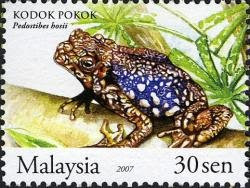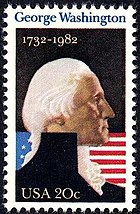 Lesser Swamp Frog (Rana (baramica) laterimaculata) Miniature Sheet Stamp
Lesser Swamp Frog (Rana (baramica) laterimaculata) Miniature Sheet StampLesser Swamp Frogs has a thin line on the upper lip that continues towards the lower part of the eye and below the eardrum. Its dorsal colour can vary from medium reddish-brown to very dark brown while the underside is creamy coloured.
Swampy areas, primary and secondary forests are the natural habitat of this species and can be easily found in West Malaysia, Singapore and the Borneo Islands.
 Spotted Tree Frog (Nyctixalus Pictus) Stamp
Spotted Tree Frog (Nyctixalus Pictus) StampDenomination : 30sen
Stamp Size : 40mm x 30mm
Spotted Tree Frogs is small with relatively long snout and long hind limbs. The skin on the back, head and upper surface of the limbs is rough, with many small, spiny bumps. The body is reddish cinnamon brown or pale red with white spots scattered on its back and, along the edge of the snout and even on the upper eyelid.
The upper half of the iris of the eye is white while the lower half is brown. This is one of the most distinctly coloured and cannot be mistaken for any other species. The size of Spotted Tree Frogs is almost the same with the exception of the female being slightly larger than the male.
Spotted Tree Frogs lives in primary and old secondary forests and can be found most often in hilly terrains near water areas at all parts of Borneo except for Brunei, southern Thailand, Peninsular Malaysia, Singapore, Sumatra and the Phillipines
 Horned Toad (Megophrys nasuta) Stamp
Horned Toad (Megophrys nasuta) StampStamp Size : 40mm x 30mm
Megophys nasuta have specific features that are different from other types of toads. The ‘horn’ is very wide and pointed, with triangular projection from the edge of both eyelids. The hind legs are shorter than the front legs and normally males are substantially smaller than females. The colour is light clay to reddish red with one or two dark spots on the back.
Using its leaf-like appearance for camouflage, the Horned Toad is virtually undetectable in the leaf litter of the forest unless it moves. The animal is perfectly designed to fit in with its surrounding.
The Horned Toad lives in flat to steep rain forest where thick bamboo grows and the area is damp and cool. It is commonly found throughout Borneo, Sumatra and Peninsular Malaysia
 Brown Tree Toad (Pedostibes hosii) Stamp
Brown Tree Toad (Pedostibes hosii) StampDenomination : 30sen
Stamp Size : 40mm x 30mm
The Brown Tree Toad has a large, stout body with a thick bony ridge behind the eye and connected to a small paratoid gland. The fingers are long and distinctly shaped, probably an adaptation to enable this species to climb trees. The top of its head is smooth and the back has a few scattered warts.
The female’s size is bigger than the male, while the colour difference between both genders is light brown for male and black or dark purple with a pattern of yellow spots for female. It can be found mostly in undisturbed forests, but may also be found in old, secondary forests. The Brown Tree Toad can be found in all parts of Borneo as well as in Sumatra, Peninsular Malaysia and southern Thailand
 Wallace’s Flying Frog (Rhacophorus nigropalmatus) Miniature Sheet
Wallace’s Flying Frog (Rhacophorus nigropalmatus) Miniature SheetWallace’s Flying Frog is a very large tree frog with an almost rounded snout and very large hands and feet. The fingers and toes are fully webbed while the colour of its body is shiny green with light yellow on the lateral sides as well as on the toe pads and snout. The hind limbs are relatively larger than the front limbs that provide added thrust upon jumping.
The males are slightly smaller than the females. Wallace’s Flying Frogs lives in primary or logged forests at low elevation. It can also be found on low tree branches near rain puddles by the logging area after a heavy rain. It descends from the forest canopy to breed at muddy pools of water. Wallace’s Flying Frog can be found in Kalimantan, Peninsular Malaysia, Sumatra, southern Thailand, Sabah and Sarawak.








